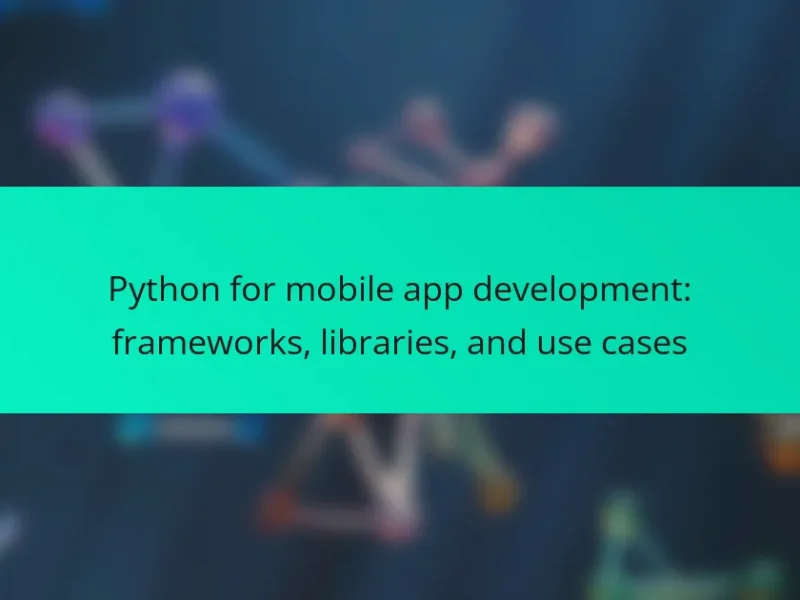React Native is an open-source framework developed by Facebook for creating cross-platform mobile applications using JavaScript and React. It enables developers to build applications for both iOS and Android from a single codebase, which significantly reduces development time and costs while providing a native look and feel. The article covers the benefits of using React Native, its architecture, and common use cases, highlighting popular applications built with the framework. Additionally, it discusses future trends, including the adoption of TypeScript, integration with emerging technologies like AR and VR, and ongoing enhancements to performance and community resources.

What is React Native and why is it important for mobile app development?
React Native is an open-source framework developed by Facebook for building mobile applications using JavaScript and React. It allows developers to create applications for both iOS and Android platforms from a single codebase. This cross-platform capability significantly reduces development time and costs. React Native provides a native look and feel by rendering components using native APIs. This results in better performance compared to traditional hybrid apps. The framework has a large community and extensive libraries, making it easier to find solutions and resources. According to a survey by Stack Overflow, React Native is among the top frameworks used by developers, highlighting its popularity and effectiveness in mobile app development.
How does React Native enable cross-platform mobile app development?
React Native enables cross-platform mobile app development by allowing developers to write code once and deploy it on both iOS and Android platforms. It uses a single codebase, which reduces development time and costs. React Native translates the code into native components, ensuring high performance and a smooth user experience. The framework supports hot reloading, allowing developers to see changes in real-time without recompiling the app. Additionally, React Native has a large community and ecosystem of libraries, which facilitates faster development. This approach can lead to significant savings in resources and time compared to building separate apps for each platform.
What are the key features of React Native that support cross-platform capabilities?
React Native enables cross-platform capabilities through several key features. Its core feature is the use of a single codebase for both iOS and Android applications. This significantly reduces development time and costs. React Native also utilizes native components, allowing apps to achieve a look and feel similar to native apps. Hot reloading is another feature that allows developers to see changes in real time without recompiling the entire app. Additionally, React Native supports third-party plugins, which enhances functionality and reduces the need for custom native code. The framework also offers a strong community and ecosystem, providing access to a wealth of libraries and tools. These features collectively enhance the efficiency and effectiveness of cross-platform mobile app development.
How does React Native compare to other mobile development frameworks?
React Native is a popular mobile development framework that allows for cross-platform app development. It offers a unique advantage by enabling developers to write code once and deploy it on both iOS and Android platforms. This significantly reduces development time and costs compared to native frameworks, which require separate codebases for each platform.
In contrast, frameworks like Flutter also support cross-platform development but utilize different programming languages and architectures. Flutter uses Dart, while React Native primarily relies on JavaScript. This can affect the learning curve for developers familiar with each language.
Additionally, React Native has a large community and extensive libraries, which can accelerate development. Other frameworks may not have the same level of community support or resources.
Performance-wise, React Native’s use of native components can lead to better performance than hybrid frameworks like Ionic, which rely heavily on web technologies. However, in some cases, pure native development may outperform React Native in terms of speed and efficiency.
Overall, React Native offers a balanced approach to mobile app development, combining efficiency, community support, and performance, making it competitive with other frameworks.
What are the main benefits of using React Native for mobile app development?
The main benefits of using React Native for mobile app development include cross-platform compatibility, faster development time, and a rich ecosystem. React Native allows developers to write code once and deploy it on both iOS and Android. This significantly reduces the time and cost associated with app development. According to a survey by Stack Overflow, over 42% of developers prefer React Native for its efficiency. Additionally, it provides a seamless user experience with native-like performance. The framework also has a large community and numerous libraries, enhancing its functionality.
How does React Native improve development speed and efficiency?
React Native improves development speed and efficiency by enabling code reuse across platforms. Developers can write a single codebase for both iOS and Android applications. This reduces the time spent on building separate apps for each platform. The framework offers a hot-reloading feature, allowing developers to see changes instantly without recompiling the entire app. React Native also utilizes a component-based architecture, which promotes reusability and simplifies the development process. According to a survey by Stack Overflow, 42% of developers reported increased productivity using React Native. This demonstrates its effectiveness in speeding up mobile app development.
What cost savings can developers expect when using React Native?
Developers can expect significant cost savings when using React Native. This framework allows for code reuse across iOS and Android platforms. By sharing up to 90% of the codebase, development time is reduced. Faster development translates to lower labor costs. React Native also minimizes the need for separate teams for each platform. This consolidation further cuts expenses. Additionally, the framework’s efficiency leads to quicker time-to-market for applications. According to a study by Deloitte, companies can save up to 30% on development costs using cross-platform solutions like React Native.
How does React Native enhance user experience across platforms?
React Native enhances user experience across platforms by providing a consistent look and feel in applications. It allows developers to write code once and deploy it on both iOS and Android. This reduces development time and costs significantly. The framework uses native components, ensuring smooth performance and responsiveness. Users experience faster load times and smoother animations. React Native also supports hot reloading, enabling real-time updates without losing the application state. This feature allows for quicker iterations and improvements based on user feedback. Overall, React Native creates a seamless and efficient user experience across different devices.
What are the architectural components of React Native?
The architectural components of React Native include the JavaScript thread, native modules, and the bridge. The JavaScript thread is where the JavaScript code executes. It handles the UI logic and communicates with native components. Native modules are the components that allow JavaScript to interact with native APIs. They are essential for accessing device features like camera and GPS. The bridge connects the JavaScript thread and native modules. It enables asynchronous communication between JavaScript and native code. This architecture allows for high performance and smooth user experiences in mobile applications. React Native’s architecture effectively supports cross-platform development by sharing code across iOS and Android.
What is the role of the JavaScript bridge in React Native architecture?
The JavaScript bridge in React Native architecture facilitates communication between the JavaScript code and native modules. It acts as a conduit for sending asynchronous messages. This bridge enables JavaScript to invoke native functions and vice versa. It ensures that the UI remains responsive by processing tasks in separate threads. The bridge uses a JSON-based protocol for data serialization. This design allows for efficient data exchange between the two environments. Consequently, the performance of the app can be optimized. The bridge is essential for maintaining the cross-platform capabilities of React Native.
How do native modules interact with React Native applications?
Native modules extend React Native applications by providing access to platform-specific APIs. They allow React Native to leverage native functionalities not available in JavaScript. Developers create native modules in Java or Objective-C for Android and iOS, respectively. These modules can then be invoked from JavaScript code. This interaction occurs through a bridge that facilitates communication between JavaScript and native code. The bridge converts data types to ensure compatibility. Native modules improve performance for resource-intensive tasks. They enable the use of device features like GPS, camera, and accelerometer directly within the app. This integration enhances the overall functionality and user experience of React Native applications.
How can developers effectively utilize React Native in their projects?
Developers can effectively utilize React Native by leveraging its component-based architecture. This allows for the reuse of code across different platforms. Utilizing third-party libraries enhances functionality and accelerates development. Developers should also adopt best practices for state management, such as using Redux or Context API. Testing components individually ensures reliability and performance. Implementing responsive design techniques improves user experience on various devices. Additionally, using tools like Expo simplifies the development process and provides a rich set of features. React Native’s hot reloading capability allows for real-time updates, increasing productivity. According to a survey by Stack Overflow, React Native is one of the most popular frameworks for mobile development, indicating its effectiveness in real-world applications.
What are the best practices for structuring a React Native application?
The best practices for structuring a React Native application include organizing files by feature and using a modular architecture. This approach enhances maintainability and scalability. Group related components, styles, and tests together. Use a consistent naming convention for files and folders to improve clarity. Implement a centralized state management solution like Redux or Context API. This helps manage application state effectively. Utilize component libraries to avoid reinventing the wheel and promote reusability. Follow the principles of separation of concerns to keep code organized. Regularly refactor code to improve quality and performance. These practices lead to a more efficient development process and a better end-user experience.
How can developers troubleshoot common issues in React Native?
Developers can troubleshoot common issues in React Native by following systematic approaches. First, they should check the error messages in the console for specific guidance. Understanding the stack trace can help pinpoint the source of the issue. Next, developers can use React Native’s built-in debugging tools like Flipper. Flipper provides insights into network requests and performance.
Additionally, they can leverage the React DevTools for inspecting component hierarchies and states. Running the app in development mode allows for hot reloading, which helps identify issues quickly. Developers should also consult the official React Native documentation for troubleshooting guides.
Furthermore, engaging with community forums like Stack Overflow can provide solutions from other developers who faced similar issues. Regularly updating dependencies can prevent compatibility problems. Finally, writing unit tests can catch issues early in the development process.

What are the most common use cases for React Native?
The most common use cases for React Native include building cross-platform mobile applications. Companies often choose React Native for its ability to create apps for both iOS and Android from a single codebase. This reduces development time and costs significantly. Popular applications like Facebook, Instagram, and Airbnb were developed using React Native. The framework allows for rapid iteration and updates, enhancing user experience. Additionally, React Native supports a wide range of third-party libraries, which expands its functionality. Its performance is comparable to native apps, making it a preferred choice for many developers.
Which types of applications are best suited for React Native development?
React Native is best suited for mobile applications that require cross-platform compatibility. This includes applications that target both iOS and Android platforms with a single codebase. Social media apps benefit from React Native’s fast development cycle. E-commerce applications can leverage its performance for a seamless user experience. Applications with real-time features, like chat apps, also perform well with React Native. Additionally, applications that require frequent updates and iterations are ideal candidates. React Native’s hot reloading feature allows for rapid testing and deployment. This framework is particularly effective for MVPs, enabling quick market entry.
How do businesses leverage React Native for e-commerce applications?
Businesses leverage React Native for e-commerce applications by creating cross-platform mobile apps that enhance user experience. React Native allows for faster development cycles due to its reusable components. This framework enables seamless integration of third-party APIs, improving functionality. Businesses can maintain a single codebase for both iOS and Android, reducing costs and effort. The performance of React Native apps is close to native apps, ensuring smooth interactions. Additionally, businesses benefit from a large community and extensive libraries, facilitating quick problem-solving. According to a survey by Stack Overflow, React Native is one of the top frameworks used for mobile development, indicating its popularity and reliability in e-commerce solutions.
What are the advantages of using React Native for social media apps?
React Native offers several advantages for social media apps. It enables cross-platform development, allowing developers to write code once and deploy it on both iOS and Android. This reduces development time and costs significantly. React Native also provides a rich set of pre-built components, which accelerates the design process. The framework supports hot reloading, allowing developers to see changes in real-time without losing the app’s state. Additionally, React Native has a strong community, providing ample resources and libraries. It also enhances user experience with smooth animations and fast performance. According to a survey by Stack Overflow, React Native is among the top frameworks used by developers, highlighting its popularity and reliability.
What industries are adopting React Native for app development?
Industries adopting React Native for app development include e-commerce, healthcare, and finance. E-commerce companies use React Native for its efficient performance and fast development cycles. Healthcare apps benefit from React Native’s ability to create cross-platform solutions quickly. The finance sector utilizes React Native for secure and responsive mobile applications. Additionally, education and entertainment industries are also leveraging React Native for its versatility. According to a 2021 survey by Stack Overflow, React Native is among the top frameworks used by developers, indicating its widespread adoption across various sectors.
How is React Native transforming the healthcare app landscape?
React Native is transforming the healthcare app landscape by enabling rapid development of cross-platform applications. Developers can build apps for both iOS and Android using a single codebase. This significantly reduces development time and costs. Healthcare organizations can deploy updates more quickly and efficiently. React Native’s performance is comparable to native apps, ensuring a smooth user experience. The framework supports real-time data processing, which is crucial for applications that monitor health metrics. Additionally, its large community provides extensive libraries and resources, enhancing functionality. These capabilities lead to improved patient engagement and streamlined healthcare services.
What role does React Native play in the entertainment industry?
React Native plays a significant role in the entertainment industry by enabling the development of cross-platform mobile applications. It allows developers to create apps for both iOS and Android using a single codebase. This reduces development time and costs, making it efficient for entertainment companies. Popular streaming services, like Instagram and Facebook, utilize React Native for their mobile apps. The framework supports rich user interfaces and smooth animations, essential for engaging entertainment experiences. Additionally, React Native’s community and libraries provide resources that enhance app functionality. This versatility makes it a preferred choice for entertainment app development.

What are the future trends for React Native in mobile app development?
Future trends for React Native in mobile app development include increased adoption of TypeScript for improved type safety. This shift enhances code quality and developer productivity. Another trend is the rise of React Native for web applications, expanding its use beyond mobile. Additionally, integration with emerging technologies like AR and VR is expected to grow. This will allow developers to create more immersive experiences. Performance improvements through native modules and optimized rendering are also anticipated. These enhancements will address previous limitations of React Native. Finally, the community-driven ecosystem will continue to evolve, offering more libraries and tools. This will further streamline the development process and enhance functionality.
How is community support influencing the evolution of React Native?
Community support significantly influences the evolution of React Native. This influence manifests through contributions such as open-source libraries and frameworks. Developers actively share solutions and enhancements, which accelerates feature development. Community-driven discussions often lead to important updates and bug fixes. For instance, GitHub hosts numerous repositories that enhance React Native’s capabilities. The community also provides extensive documentation and tutorials, facilitating easier onboarding for new developers. Engagement in forums like Stack Overflow helps troubleshoot issues quickly, improving overall user experience. Additionally, community feedback shapes priorities for future releases, ensuring the framework evolves according to user needs.
What upcoming features are being anticipated in future React Native releases?
Upcoming features in future React Native releases include improved performance optimizations. The enhancements aim to reduce the startup time of applications. Another anticipated feature is the introduction of new architecture with Fabric and TurboModules. This architecture will facilitate better interoperability with native modules. Additionally, there is an expectation for improved support for concurrent rendering. This will enable smoother user experiences during interactions. Enhanced tooling for debugging and performance monitoring is also on the horizon. These updates are part of ongoing efforts to streamline cross-platform development.
What tips can developers follow to maximize their success with React Native?
To maximize success with React Native, developers should focus on leveraging its component-based architecture. This approach promotes code reusability and simplifies maintenance. Developers should also utilize third-party libraries to enhance functionality and speed up development. Keeping up with the latest updates from the React Native community ensures access to new features and improvements. Implementing performance optimization techniques, like using the FlatList component for rendering large lists, is crucial. Testing on multiple devices early in the development process helps identify platform-specific issues. Additionally, following best practices for state management, such as using Redux, can lead to more manageable code. Regularly reviewing documentation and engaging with community forums fosters continuous learning and problem-solving. These strategies collectively enhance the development experience and project outcomes.
How can developers stay updated with the latest React Native developments?
Developers can stay updated with the latest React Native developments by following key resources. Official documentation on the React Native website provides the most accurate and current information. Engaging with the React Native community on platforms like GitHub fosters collaboration and knowledge sharing. Subscribing to newsletters such as React Native Newsletter delivers curated content directly to inboxes. Attending conferences and meetups focused on React Native offers networking and learning opportunities. Following influential developers and contributors on social media platforms keeps developers informed about new trends. Regularly checking forums like Stack Overflow helps in addressing specific questions and discovering updates. Utilizing online courses and tutorials ensures hands-on learning of new features. These methods collectively enhance a developer’s understanding and application of React Native advancements.
What resources are available for learning and mastering React Native?
Comprehensive resources for learning and mastering React Native include official documentation, online courses, and community forums. The official React Native documentation provides detailed guides and API references, making it an essential starting point. Platforms like Udemy and Coursera offer structured courses that cover both beginner and advanced topics. Books such as “React Native in Action” provide in-depth explanations and practical examples. Community forums like Stack Overflow and Reddit allow developers to seek help and share knowledge. Additionally, GitHub repositories contain numerous open-source projects that serve as practical examples. These resources collectively support a thorough understanding of React Native development.
React Native is a cross-platform mobile app development framework created by Facebook that enables developers to build applications for both iOS and Android using a single codebase. The article outlines the benefits of React Native, including reduced development time and costs, improved performance through native components, and a strong community support ecosystem. It explores the framework’s architecture, including the role of the JavaScript bridge and native modules, as well as common use cases in industries such as e-commerce, healthcare, and entertainment. Additionally, the article highlights future trends and best practices for developers to maximize their success with React Native.


